Day 2 – 26th March, 2019
How the digital impacts different sectors
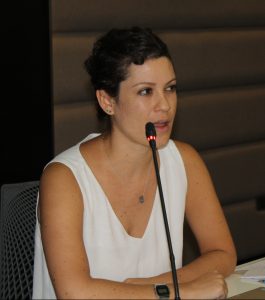
Mariana Valente
Session 5 consisted of sectoral and thematic presentations on the impact of the digital. It started with presentations on digitization and gender by Gita Sen from Development Alternatives with Women for a New Era (DAWN) and Mariana Valente from InternetLab.
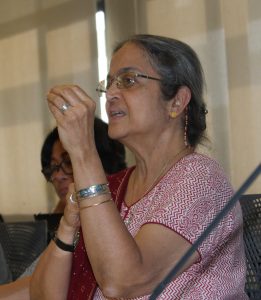
Gita Sen
Gita spoke about how we need to think of gender not as a sector but as an indispensable part of any policy, and one to be integrated from the beginning. Human reproduction is imbricated in gender relations, and in our current reality, we do not reproduce ourselves as human beings except through gender relations. Under capitalism, gender has been struggling at the margins because human reproduction itself has been relegated to the margins. This has led to tropes of victimization of women emerging since the 1970s. We should replace this trope, because everyone is a victim under the current system. What happens to women because of the fractured relationship between production and reproduction is often a forewarning of what will happen overall. You can see that might be the case in the digital justice conversation as well. Women may be the first to experience the negative impact of the system.
Feminists have been working on digital justice issues such as:
1. Macro-economics: Finance, trade, and tax justice are all critically affected by what has happened between the third and fourth industrial revolution. They govern for us the larger scope of policy and regulation.
2. Livelihoods: Gender plays a critical role here, because it is the responsibility of women to take care of survival, not just biologically but on a day to day basis. Agriculture, fisheries, deep sea mining, and the blue economy are all part of this and related to gender.
3. Labor: We should be concerned about what happens in factories, but also about informal and unpaid work, the bulk of which is women’s responsiblity. When there are no resources to provide social protection, the tax on women through unpaid work becomes unbearable.
4. There equally exist critical connections between gender and education, health, etc.
We need to humanize the digital justice conversation. Humanizing the digital justice debate is central to not being swept away in a sea of robots.
Mariana spoke about how in the 1990s, the internet provided a real opportunity. It has been allowing the formation of counter publics and has facilitated the flourishing of feminist discourse.
The current issues are many:
1. Social networks: there are issues about empowerment through activism and the oppositional interpretation of things. Non-consensual images and hate speech affect women disproportionately. A This affects women in politics and visible women even more. Facebook is full of mainly conservative discourse, usually mocking feminists.
2. Sexism online: The separation of online and offline is flawed. Surveillance applies in particular forms to women at risk. One of the strategies to deal with sexism has been call out practices like #MeToo. Beyond this, we also need to measure women’s participation online through time and activities undertaken.
3. Violence and visibility: Women walk a thin line on the internet. They are punished when they cross the invisible line. We must remember that violence is the maintenance of social order, not the breach of it.
4. Digital security discourse: Workshops for security could mean women have to protect themselves as if the problem was not the inequalities they face, but their own lack of effort.
5. Privacy: The private is public was a feminist call. Privacy was generally a value for men in that sense, and it now needs to be understood from a feminist lens.
Databases are often incomplete or inaccurate, like in the case of data on health or violence. Further, Data is sometimes not broken down by gender, and is not contextualized. We need more theory to understand data, because without an understanding of the deep context, data can mislead us. Machine learning, for instance, learns from sexist patterns of behavior in real life.
Discussions on this topic covered the following issues:
There is a pink-washing of agendas in trade, where e-commerce rules are shown to be desirable because they supposedly promote female entrepreneurship, when in reality they would be detrimental to the vast majority of women in the Global South.
The co-option of the feminist agenda is happening across sectors. ‘He For She’ is a campaign of placation, not of disruption.
A lot of digital work was done by women in the 1940s and 1950s. As an industry becomes digitalized, it becomes male dominated and then becomes highly paid. This is likely to happen also to, for instance, the garment industry as it is digitalizing now.
Digitalization is supposed to be labor saving, but this is not true in terms of public services. Public services are now just being relegated to the unpaid work of women, because social protection is being removed.
The actual people who create algorithms matter. If white, male cultures dominate in the creation of machine learning algorithms, the latter’s sexism is unsurprising.
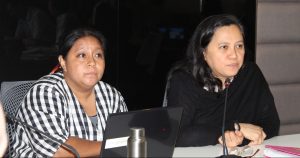
Kartini Samon & Elenita (Neth) Daño
After this, Elenita (Neth) Daño from ETC Group and Kartini Samon from GRAIN made presentations on digitization and agriculture.
Neth spoke about how the peasant food web feeds the world, and how there is growing concentration in agriculture today. In 2016, six companies controlled 60% of the global seed market and 75% of the global pesticides market. These were Syngenta, DuPont, Dow, Bayer, BASF SE, and Monsanto. Then, the three largest mega-mergers in agriculture took place. ChemChina acquired Syngenta, Dow and DuPont merged, and Bayer absorbed Monsanto. Today, the agricultural inputs market is controlled by these three and BASF SE. Thus, the Big 6 have now changed into the Fat 4.
Concentration in ownership is growing not only in agrochemicals, seeds, fertilizers, and farm machinery, but also in agricultural commodity trading. The future in agriculture is data-driven. Companies focus on acquiring seed, soil, pests, micro-climate, and other data. Now they have consolidated. Monsanto’s acquisition of the micro-climate data company ‘The Climate Corporation’ was a turning point.
Digitalization is fortifying the move towards vertical integration in agriculture. New enclosures are being created due to digitization: The Fat 4, the commodity traders and farm machine manufacturers are all interconnected even more through digitization.
The complete package of digitization is about big data and is driven by who owns data and genomics. It no longer makes sense to examine one sector in the industry, because it is all being consolidated into one chain. The borders between seeds, chemicals, farm machinery and fertilizers are blurring. The impact of digitization is going beyond food and agriculture, to society, culture, economy, the environment, politics, and ethics.
There are interconnections between digital and data driven technology, automation and sensing, molecular engineering, and earth systems engineering and ecosystem interventions. The big farms don’t need active human managers anymore.
The presentation can be found here
Kartini spoke about digitalization and challenges for food sovereignty. An OECD report on food, agriculture, and fisheries says that the agricultural sector is both an important consumer and supplier of data. The collection and use of farm data is going hand in hand with global value chain integration. The FAO and EU see datafication as new developments that are full of promise.
The face of Asian food markets is changing rapidly, as over half of global food sales are now through supermarkets and hypermarkets. The traditional markets are closing down, and this is affecting women in particular adversely. All this is occurring while Asia has the fastest growing retail food sector in the world.
FDI in retail means unprecedented entry of foreign firms into countries where a large section of the population depends on agricultural earnings. This includes not just farmers but also everyone on the chain, like street vendors, small traders of fresh produce, etc.
Agriculture is now seeing the emergence of new retail. “New retail” is a term coined by Jack Ma to describe the merger of online and offline retail stores, soon announced as Alibaba’s company strategy. All this is connected to trade: Alibaba has direct supplies from New Zealand, and indulges in anti-competitive practices. It has put out a new competition call for AI solutions to detect food safety.
But by far the biggest “new retail” deal has been the acquisition of Whole Foods by Amazon. It has threatened conventional retail companies like Walmart who are in turn aggressively seeking to merge with online retail companies.
The intertwining of grocery and online companies is also a test-bed to try out new technologies, such as unmanned greenhouse/farm, stores, or shaping consumers behavior through the use of consumer data and analytics to optimize the vertical value-chain.
For example, unmanned vegetable factories and smart agriculture are now being explored. At the same time as new retail gets a red carpet welcome, traditional markets are being forcibly closed down, and there is a lot of resistance to this.
Under precision farming and unmanned farms, few humans are required to produce food. Where do we expect people to go when these jobs disappear?
Discussions on this topic covered the following issues:
1. There is a perverse connection between industrialization of food and health. There are adverse health effects and consumerizm, and a whole new industry is created to deal with this.
2. Many IP laws are becoming superfluous because of databases on genetic sequences, which do not attribute to sources.
3. The change in agriculture that digitization is bringing is not just a change in the supply chain. It is brutal and sophisticated end-to-end exploitation.
4. The business model of e-commerce needs to be understood better by agriculture activists. Are e-commerce companies selling milk, or are they selling platform and finance?
5. All rights and protections that exist for the offline world are not transferred online. Digital bio-piracy of farmers’ datasets is a serious threat. In 10 years’ time, we won’t have any resources that are not locked up.
6. The environmental aspect of these changes is a crucial one to discuss. These new technologies are far from resource efficient. Cryptocurrency, for example, notoriously over-consumes power. Rare earth minerals are mined indiscriminately for producing new devices.
The presentation can be found here.
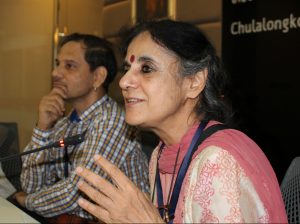
Anita Rampal & Gurumurthy Kasinathan
This was followed by presentations by Anita Rampal, formerly at Delhi University, and Gurumurthy Kasinathan from IT for Change, on digitalization and education.
Anita spoke about the new militaristic ideas in education policy, with nations seeking to out-think and out-educate everyone else. There are separate commissions in place on skill development and knowledge commission, as if the two don’t intersect in reality. The economy of knowledge works by segregating children and creating a dichotomy as highlighted above: of skill vs. knowledge. Two examples of this are: 1. Mathematics is used as a filter to sort children: sometimes into those who are “talented” and those who are “committed”. 2. Laws are being pushed that would introduce vocational education in grade 3.
This is due to neoliberalization of education, one of the signs of which is India’s decision to participate in the Program for International Student Assessment (PISA). The captive market that education offers is huge. The budget private schools market is a billion dollar industry. We need to reframe and craft a new education by bringing in artisanal knowledge.
With digitalization, there is a use of deficit paradigms to sort children. Technology is misused here. It is necessary to understand the politics of intelligence and the imperial role of AI in education. The way to counter this is through Global South solidarity for alternative learning indicators. Perhaps we need to look at place based pedagogies. For this, there are many frameworks to consider, like the Gandhian framework, Nayi Taleem, etc.
The presentation can be found here
Gurumurthy spoke about how the neoliberal vision was one of factories without workers, farms without farmers, and schools without teachers. Education is facing huge pressure. The bureaucracy sees teachers as the problem, which ties in with technologies such as the use of CCTVs in classrooms, rules around how teachers must carry tablets with the location on, and so on. The system is setting up parents and teachers as adversaries.
Education is certainly a lucrative market. Encouragingly, there is some element of endogenous technological appropriation by schools and teachers. We must look at teachers as creators and at developing their collectives through digital networks. The bureaucracy, however, does not want to let teachers collectivize.
The Government of India has a policy preferring free and open source technology in public education, which can enable local creativity.
Predictive models like those of IBM Watson are already being used in India. If these developments continue, Google, which has a huge amount of schools’ data, will direct teachers on what to teach and how to teach. There will be a rise of personal analysis driven learning.
There are two major issues around digitalization in education now:
1. The ownership of technology, platforms, and data: We should seek local ownership for technology and platforms. Should schools own the data generated in schools? India’s NITI Aayog is encouraging IBM to collect student and school data. The problem is not just piracy, it is proprietizing otherwise locally available data. We always have to be conscious of where power resides, and to place technology in control of those whom it affects.
2. The role of digital intelligence: AI has the potential, for instance, to exacerbate the caste system, as it uses past patterns to predict the future. Remaining conscious of such pitfalls of digital technologies is important.
Discussions on this topic covered the following issues:
1. There are huge concerns about this brave new world of digitalized education, with respect to how it deals with the humanities, history, philosophy, ethics and social injustice.
2. Educational conferences are funded heavily by large corporations where such agendas are pushed.
3. There have been attacks on the freedom of expression of teachers; and children at schools are being monitored, sometimes with facial recognition software. Such data is not protected. We need non-negotiables on the sharing and protection of children’s data.
4. Data can now recognize patterns, providing correlations, without the intermediate step of theory and abstraction. Knowledge making has both a functional and normative-human aspect. The functional aspect may partly be replaced by AI but the normative part cannot.
5. Humanities can bring in critical thinking to the creation of AI. Thus we need to create links between the two.
6. There is a large amount of funding from US organizations like the Gates Foundation. We must remain aware of biases and dependencies that are introduced through this and through international rankings.

Georgios Altintzis
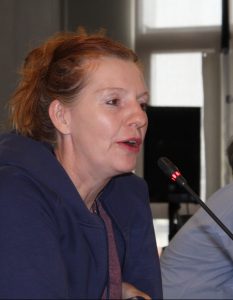
Kate Lappin
After this, Kate Lappin from Public Services International and Georgios Altintzis from International Trade Union Confederation spoke on digitalization and labor.
Kate started by speaking about how the data-intensive projects of smart cities are really about turning local governments into corporate controlled cities. 99 cities in India are moving in this direction. Enormous data capture is being undertaken with this venture. The cities are digitalized and, through this expedient, privatized.
The digitalization of services, such as health services, is also a similar phenomenon. The collection of health data is leading to its privatization to the benefit of the health industry.
Some governments are trying to resist such privatization through the digital route. The city of Barcelona has sought to return such data to the public, by democratizing its use. In Norway, the local government is looking at data as a public resource.
Georgios spoke about the extra-territoriality introduced by foreign e-commerce firms. There is no rule of labor law in this domain, and companies are registered in tax havens. Such lacunae already exist, but they will be amplified by the data economy.
In the post-market economy, updating laws can be futile.
Work place surveillance is a big issue for trade unions around the world. The use of algorithms to determine workers’ entitlements and rights means this process is opaque, and often workers or even governments are not able to access source codes to understand decision making.
Digitalization has accentuated financialization of the economy, thereby moving away from the real economy and real workers. Labor is losing its power to bargain.
Discussions on this topic covered the following issues:
1. We have a lot to learn from feminism, in terms of new theories of work and labor in the digital economy.
2. There are examples of workers being pitted against one another in this new economy. For example, traditional taxi driver unions have been violent against Uber drivers. This happens because the real enemy is absent and invisible.
3. We are now talking about extra territoriality, or a global assembly line of female workers, already ignored by unions for two decades. Public sector workers are largely women. Women workers also work in MSMEs. We also cannot do alternative digital organizing unless we deal with unpaid work. Further, The existence of gig work, and its current discontents, presents an opportunity to organize anew.
4. Informal contracts are relied upon to avoid regularization and to prevent unionization of workers.
5. The trade union movement has so far been unable to harvest anger at the new economy and direct it to the right place, whereas fascist movements have been successful at misdirecting this anger.

Sean O’Siochru
The next set of presentations were by Renata Mielli from National Forum of Democratization of Communication (FNDC) and Sean O’Siochru from Nexus, on digitalization, media and democracy.
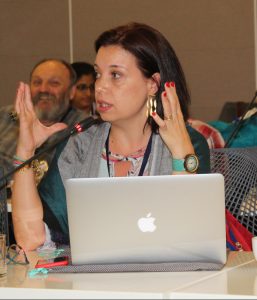
Renata Mielli
Renata spoke on the role of the media in the reproduction of political and economic power in modern societies. The media has always been part of structures of ideological domination. In the pre-internet era, information manipulation patterns were well known. What has changed with the internet?
With Web 2.0, a part of the social movement felt that we do not need to democratize communication anymore, because the internet has already done it for us. It was the end of the middlemen. But this situation brings us to the stage where everyone talks at the same time, no one listens. This is not really democratic, because we are not talking about an individual right, but a collective one. Besides, a new intermediary has emerged: private platforms – social networks and search engines. They select what should and should not be seen and read from a much more powerful input than opinion polls made in the past. They use our data in a totally opaque way. And in the midst of so much information, their selection is imperceptible.
The manipulation is no longer of masses, it is of individuals. This excess information leaves us incapable of discerning the real from the imaginary.
We have a problem of how to construct narratives in this new digital environment, without using the same resources that the ultra-right uses. The new digital monopolies are sucking the internet into themselves, because of their business model based on attention, interaction and data collection, and they need to keep people for longer within their walls.
Right-wing sections that have used data and platforms to interfere in electoral results worldwide are raising the banner of free speech to defend their racist, sexist, homophobic, fascist speeches. The new fight against these platforms is not only against their monopoly character but also for content management and governance of algorithms. We need to re-qualify the debate and the concept of freedom of expression, the right to communication and democracy. But: who will arbitrate on this content? How can we prepare the justice system to have more agility and quality in the analysis of these issues?
You can find full notes here.
Sean spoke about right to communicate. At the early stages of the internet, people felt it was going to be a sort of megaphone, using which, you could get your voice out. But they soon found that there were different barriers to the other areas of the right to communicate: to being heard (for instance, the barrier of language); to being understood (the barrier of education); or the inability to access information because of intellectual property rights.
Thus, the right to communicate is not just the freedom to express, but also:
1. The right to be heard.
2. The right to be understood.
3. The right to learn, enhance and create.
4. The right to respond and share.
5. The right to seek and receive rights.
6. The right to generate ideas and opinions.
Which all loop back into the right to express and speak. The problem, therefore, is not one of freedom of expression, but of all these other rights.
Sean and some other scholars have developed a four-way framework of communication rights. This includes: communicating in the public sphere, communicating knowledge, civil rights in communication, and cultural rights in communication. It tries to cover all the potential barriers to enabling that cycle of communication to become a reality at the level of society. It is social from the outset, which radically differentiates it from the ideas of free speech. We need to look at social relations and collective rights.
Years ago, they had developed two poles for future possibilities – the first scenario is the dominant trade liberalization paradigm. The second scenario is multilateral cooperation reborn. Between these two, considered quite extreme, they argued that there is a role for civil society. Looking back on this today, the dominant trade liberalization paradigm at the time looks like the positive scenario rather than the negative one, and that indicates just how badly things have gone. On the positive side, the strategies proposed years ago to get to the second scenario still apply: rewriting trade rules, global development-oriented public media, support for local media, etc.
Discussions on this topic covered the following issues:
1. We need new perspectives on content regulation for new media, that take into account personal data protection without limiting free expression.
2. The rules of democracy are from a pre-digital era. Does democracy need to refresh itself for the digital age?
3. Modernism colonized the world, and locked it into a knowledge system from which the chances of escape seem bleak.
4. There has been a codification of demands of Big Tech through agreements like the TPP, which impact all communication rights.
You can find the full presentation here.
Digital trade – the neoliberal global rulebook for the digital world
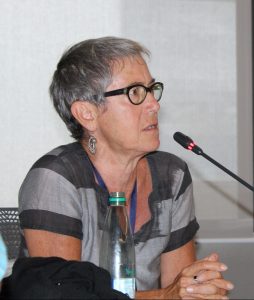
Jane Kelsey
Session 6 had a panel speaking about digital trade rules, and their impact, particularly on the Global South. This was followed by an open discussion. The panel included Jane Kelsey from the University of Auckland, Burcu Kilic from Public Citizen, Munu Martin Luther from Economic Policy Research Centre, and Barkat Maruf from COAST Trust.
Jane presented the big picture of digital trade. The development of international trade rules has always been a mechanism promoted by hegemonic powers that have been designed to facilitate and embed the particular mode of capitalism that was dominant at the time, to enable a maximization of the benefits for them. We saw it with goods, then monopolies on IP, then on services, and now in the digital arena.
The fundamentals of the rules, as they are being developed, are to effectively create a regulation free zone for the digital arena. There is an externalization of the US rulebook, where there was regulation on the telecommunication side, but a hands-off approach to the internet and the digital world. That means locking in benefits for first movers, who are the ones that dominate currently; to ensure that their oligopoly over the ecosystem, whether it is data, platforms, payments, marketplaces, algorithms, remains.
The USTR’s office developed the Digital2Dozen principles, which was effectively codification of the demands of Big Tech. This codification, through TPP, got carried through TISA, which failed. The same text is now found in a whole range of agreements. The creation of this template is strategic. There is a big push in the WTO to have these rules become global.
There are some objections raised to these digital trade rules:
1. The main objections raised by the South, and some CSO groups, unions, etc., is that this is not about trade. Trade is a Trojan horse that is being used to push rules designed to prevent the regulation of the power of dominant digital players.
2. It perpetuates development asymmetries, where the first movers lock up technology, source codes, etc. It disallows localization, seeking of technology transfers or local presence, and so on.
However, there is optimism. There has been effective resistance. There is also resistance from the counter-hegemonic force, or the competing hegemony, of China. Our strategy has to be first to keep the space open, and second to develop alternative narratives and options that allow countries to say no.

Burcu Kilic
Burcu spoke about international digital trade rules and their implications. Most issues relevant to the digital economy are part of the e-commerce chapter in various agreements. Most of the countries negotiating the TPP, that had such a chapter, simply did not know the implications of it.
Cross border data transfers are called free flow of information in Big Tech terminology. The provision first appeared in the Korea-US FTA in 2007, but it was not a hard commitment then. In the TPP, it was a much higher commitment. Big Tech had started to realize that countries were introducing regulations around data, including privacy. Any regulations introduced on data transfers, after such a provision, would have to pass this exception language, otherwise it becomes a non-tariff barrier. You have to pass a WTO test to qualify as legitimate exception, and this has not worked 44 out of the 45 times it was tried. Then these exact provisions were copied into the Singapore-Sri Lanka FTA. Singapore signed it without realising the implications, and now it cannot implement any privacy or data protection regulations that violate free flow of data. Some agreements have no exceptions whatsoever to free flow of data. This is what Big Tech wanted, and they seem to be getting it.
The other important provision is the one that disallows governments from examining source codes. In the United States-Mexico-Canada Agreement (USMCA), this also covers algorithms and prevents even judicial authorities from requiring their examination.
For three years, there have been very fierce discussions about e-commerce. In Jan 2019, 76 countries decided to go ahead to make rules about e-commerce in the WTO. You can expect the same kind of provisions as explained before, in the WTO as well. The TPP countries are the conveners of this agreement, and are pushing other countries to adopt these provisions initially drafted by the US (which itself left the TPP).
You can find the presentation here
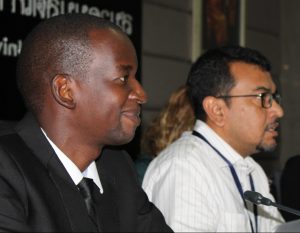
Munu Martin Luther & Barkat Maruf
Maruf spoke about the developments in digital trade as they related to Bangladesh. Digital trade today is just as undignified as captchas, where you, as a human being, prove your humanity to a robot. The Federal Reserve of Bangladesh was hacked by people outside Bangladesh, and a large amount of money was stolen. The Bank did not have the ability to protect itself against such an attack.
We need to understand the difference between the free flow of data and the free flow of information. These issues get mixed up with the issue of the Right to Information. ICT education provided by the government at the school level teaches about Microsoft, Adobe Photoshop, etc. There is nothing in this education about what AI is, how the political economy of digital trade works, etc.
These initiatives are often supply driven, and do not consider the demand on the ground. For example, IOM, an organization with the mandate of migration, is implementing an e-commerce program on a small island in Bangladesh. They are building the capacity of very small businessmen on the island, like betel leaf growers, to use e-commerce to eliminate the need for market intermediaries. But ultimately, they were trapped in the same cycle – they sold all their product to a foreign company that runs the e-commerce platform.
Bangladesh has a national e-commerce policy which is under review now. We felt it was driven by foreign companies. It wants the post office, a public institution, to serve these companies. The Digital Security Act, meant for protection against online sexual harassment, also curbed speech against the government. We have to focus on what the people’s agenda on digital issues is, and not just respond to corporate agendas. The social sector will be severely affected by these developments.
Munu spoke about the global dynamics of digital trade, and what they mean for Africa. Digitalization affects everything about us, especially under capitalism which is dominant in most countries in the world.
The discussion on trade agreements in Africa is now taking place under the Africa Continental Free Trade Area. It is trying to promote intra-Africa trade, as the continent has the least trade within itself. They expect to conclude e-commerce negotiations by 2021, and this is a matter of concern. Regional African agreements are also trying to include digital trade chapters.
We have infrastructure constraints. This has negative implications on the cost of data. This includes internet connectivity, electricity, etc. The skills gap is also high in a number of African countries. We need constant skill-building and innovation since digitalization is fast-moving.
For developing countries, industry and manufacturing are a key strategy for linking up agriculture and ultimately promoting development. Digitalization fuels trade; it is a trade facilitation platform, but it largely impacts services in Africa. Most of these platforms are developed by external corporations, and a component of domestic trade is already going out as an impact of services. Industry’s share of GDP in Africa has been declining, affecting, the terms of trade. As we try to promote intra-African trade we are still seeing an increase in imports in terms of services. There is an aggressive push for investments in Africa.
There is shrinking policy space for the development and implementation of digital industrialization policies. We need some form of protectionism for African startups and MSMEs. We need domestic revenue generation. We need discrimination in public procurement. We need data localization and technological transfer. A multilateral agreement on digital trade would make it almost impossible for such a digital industrialization policy to be implemented.
We need to protect such policy space, address domestic challenges like infrastructure, the digital divide, and inadequate regulatory frameworks. We need to maintain consistency in our trade negotiating positions, especially with national-level investment policies. We need to push for a developmental state. A number of African countries are weak in front of the power of these corporations, and their only hope is to have a state that can push for these development policies.
Discussions in this session focused on:
1. Countries like the term e-commerce, but have they really done any impact assessment? Impact assessments should be carried out with relation to the broader economy, not just at a sectoral level.
2. E-commerce isn’t just about the flow of goods and services, we are talking about possible breaches of personal information of individuals.
3. Global tech giants indulge in forum shopping. In addition to FTAs and the WTO, in June the G20 will be taking up digitalization as an agenda in Japan. All international entities are peddling the same set of rules. There is also agreement-shopping: if the objectives are not met in the e-commerce chapter, they are sought to be met with trade and services agreements. The digital agenda is redefined as services.
4. Issues like spam and cybersecurity that should have been handled by different UN agencies. The latter were blocked from handling them by the very same countries that are bringing these issues to the WTO.
5. Fundamentally e-commerce is not removed from industrialization, value chains, and global flows. There needs to be broader public awareness, particularly amongst small traders and trade unions, on the impact of e-commerce, as they start becoming marginalized. Many developing countries are dominated by MSMEs. MSMEs are so small in African countries that they cannot compete with even European MSMEs, let alone tech giants.
6. Even at the regional level, rules on e-commerce benefit different countries differently. Some countries like Kenya believe they have reached a level of development where these rules can benefit them. But other countries have concerns.
7. Different negotiators in the same developing country do not coordinate, and sometimes these countries end up agreeing to e-commerce rules in one FTA while rejecting them in another.
8. Countries conflate the potential gains from digital technologies with the framing of global trade rules. Signing on to such rules may actually exclude them from actively participating in the digital economy. We have to decode this rhetoric.
9. China has, to date, been focusing on trade-related rules, more generally. Alibaba is not that concerned about data flows, local presence, and source codes. China’s defensive interests inside China are stronger than the offensive interests of Alibaba etc. We don’t know for how long this will remain. But, China’s Belt and Road Initiative has to be talked about in the context of digitalization. China gets a free ride from African agreements.
10. These rules are really WTO 2.0. They are using e-commerce as a hook to get in all the liberalization they have been wanting. So, it is best to avoid the e-commerce framing. It is also helpful, when reaching out to the public, to speak of the business model of tech giants. The issues of deregulation, non-payment of taxes, access to markets, the exploitation of cheap labor, and the exploitation of data, then become much clearer.
11. We also need to closely examine NGO interventions, like those of IOM. Students need to be educated about the political ideas behind global digital trade.
You can find the presentation here
Developing common digital agendas

Duncan McCann
Session 7 was facilitated by Duncan McCann from New Economics Foundation and Fabien Anthony from Africa Youth Network. Participants agreed that the purpose of a common digital justice agenda should be to give us a common identity, highlight shared key issues, and frame them in an actionable manner. They then contributed their understanding of what the common digital justice agenda for the group should look like.
Some of the ideas that emerged from this session were:
1. It is critical that we name the problem. Data is the crux of the problem. We should be radical in our statements about data. We should ask for the prohibition of indiscriminate monetization of data and make clear our stance on who owns data. We should articulate clearly that in the new digital economy we are becoming the product.
2. We should demand the prohibition of targeted and personalized online advertising.
3. Although consent is great in theory, in practice it does not deliver what is expected because the time and effort required to ensure consent is disproportionate.
4. We must resist the prevailing toxic positivity of technology, but we ought to be positive in a different sense. We must make a claim on what is valuable. We should ensure that we highlight the many positive uses of data.
5. On the internet: we should show and highlight that another internet is possible. We should declare the internet a global public good, and highlight that we want an internet for the people and not for corporations.

Fabien Anthony
6. We should reject the idea that digital is the solution to everything, and certainly not a solution to complex social problems. We can use three different ways to approach digitalization in areas of concern. In some areas, we might not want any digitalization. In some, we might want to slow down digitalization. In others, we might want to proceed with digitalization on our own terms.
7. We must articulate the new forms of labor that have emerged in the digital economy, that are often not recognized as such and are certainly not remunerated. We need democratic control over the entire digital space, not just over data. This would include our approach to gig work.
8. We ought to make clear that today multinationals can, and are, expropriating knowledge.
9. We should explore the ideas of decentralization and decommodification in the digital economy.
